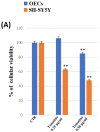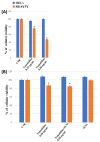Lipid Nanoparticles Loading Steroidal Alkaloids of Tomatoes Affect Neuroblastoma Cell Viability in an In Vitro Model
- PMID: 38004552
- PMCID: PMC10675799
- DOI: 10.3390/pharmaceutics15112573
Lipid Nanoparticles Loading Steroidal Alkaloids of Tomatoes Affect Neuroblastoma Cell Viability in an In Vitro Model
Abstract
Tomato by-products represent a good source of phytochemical compounds with health properties, such as the steroidal glycoalkaloid α-tomatine (α-TM) and its aglycone tomatidine (TD). Both molecules have numerous beneficial properties, such as potential anticancer activity. Unfortunately, their therapeutic application is limited due to stability and bioavailability issues. Therefore, a valid strategy seems to be their encapsulation into Solid Lipid Nanoparticles (SLN). The nanoformulations containing α-TM (α-TM-SLN) and TD (TD-SLN) were prepared by solvent-diffusion technique and subsequently characterized in terms of technological parameters (particle size, polydispersity index, zeta potential, microscopy, and calorimetric studies). To assess the effect of α-TM and TD on the percentage of cellular viability in Olfactory Ensheathing Cells (OECs), a peculiar glial cell type of the olfactory system used as normal cells, and in SH-SY5Y, a neuroblastoma cancer cell line, an MTT test was performed. In addition, the effects of empty, α-TM-SLN, and TD-SLN were tested. Our results show that the treatment of OECs with blank-SLN, free α-TM (0.25 µg/mL), and TD (0.50 µg/mL) did not induce any significant change in the percentage of cell viability when compared with the control. In contrast, in SH-SY5Y-treated cells, a significant decrease in the percentage of cell viability when compared with the control was found. In particular, the effect appeared more evident when SH-SY5Y cells were exposed to α-TM-SLN and TD-SLN. No significant effect in blank-SLN-treated SH-SY5T cells was observed. Therefore, SLN is a promising approach for the delivery of α-TM and TD.
Keywords: cellular viability; lipid nanoparticles; tomatidine; tomatine.
Conflict of interest statement
The authors declare no conflict of interest.
Figures











Similar articles
-
Steroidal Alkaloids from Food Waste of Tomato Processing Inhibit Neuroblastoma Cell Viability.Int J Mol Sci. 2023 Nov 29;24(23):16915. doi: 10.3390/ijms242316915. Int J Mol Sci. 2023. PMID: 38069237 Free PMC article.
-
Impact of solid lipid nanoparticles on 3T3 fibroblasts viability and lipid profile: The effect of curcumin and resveratrol loading.J Appl Toxicol. 2023 Feb;43(2):272-286. doi: 10.1002/jat.4379. Epub 2022 Aug 26. J Appl Toxicol. 2023. PMID: 35978497 Free PMC article.
-
The steroidal alkaloids α-tomatine and tomatidine: Panorama of their mode of action and pharmacological properties.Steroids. 2021 Dec;176:108933. doi: 10.1016/j.steroids.2021.108933. Epub 2021 Oct 23. Steroids. 2021. PMID: 34695457 Review.
-
Neurotoxicity of the steroidal alkaloids tomatine and tomatidine is RIP1 kinase- and caspase-independent and involves the eIF2α branch of the endoplasmic reticulum.J Steroid Biochem Mol Biol. 2017 Jul;171:178-186. doi: 10.1016/j.jsbmb.2017.03.009. Epub 2017 Mar 12. J Steroid Biochem Mol Biol. 2017. PMID: 28300624
-
An In Vitro Evaluation of the Potential Neuroprotective Effects of Intranasal Lipid Nanoparticles Containing Astaxanthin Obtained from Different Sources: Comparative Studies.Pharmaceutics. 2023 Mar 23;15(4):1035. doi: 10.3390/pharmaceutics15041035. Pharmaceutics. 2023. PMID: 37111521 Free PMC article.
Cited by
-
Exploratory Study on Nanoparticle Co-Delivery of Temozolomide and Ligustilide for Enhanced Brain Tumor Therapy.Pharmaceutics. 2025 Feb 4;17(2):191. doi: 10.3390/pharmaceutics17020191. Pharmaceutics. 2025. PMID: 40006558 Free PMC article.
-
Potentials of cepharanthine and tomatidine as novel LpxC and TLR4 inhibitors to mitigate gut-mediated inflammation in Parkinson's disease: a high-throughput investigation through molecular docking and dynamic simulation.3 Biotech. 2025 Jul;15(7):215. doi: 10.1007/s13205-025-04386-3. Epub 2025 Jun 16. 3 Biotech. 2025. PMID: 40535112
-
Steroidal Alkaloids from Food Waste of Tomato Processing Inhibit Neuroblastoma Cell Viability.Int J Mol Sci. 2023 Nov 29;24(23):16915. doi: 10.3390/ijms242316915. Int J Mol Sci. 2023. PMID: 38069237 Free PMC article.
References
LinkOut - more resources
Full Text Sources

